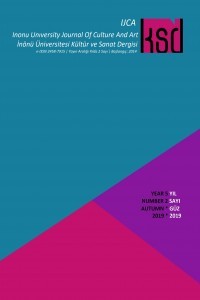EĞİTİM FAKÜLTESİ MÜZİK EĞİTİMİ ANA BİLİM DALLARINDAKİ ÖĞRENCİLERİN ÇALGI ÇALMADA EZBERİ KULLANMA DURUMLARI SİVAS ÖRNEĞİ
Bu çalışmada Eğitim Fakültelerinin Müzik Eğitimi Ana Bilim dallarındaki çalgı öğrencilerinin ezberi kullanma durumları araştırılmıştır. Çalışmanın amacı çalgı öğrencilerinin ezber yapma durumlarını belirlemek, ezberlemede en fazla hangi ezber yöntemini kullandıklarını saptamak ve ezbere çalmada karşılaştıkları güçlükleri ortaya çıkararak çözüm önerileri getirmektir. Bunu belirleyebilmek için örnekleme alınan Sivas Cumhuriyet Üniversitesi Eğitim Fakültesi Müzik Eğitimi Ana Bilim Dalında öğrenim görmekte olan öğrencilerle ve bu öğrencilerin öğretmenleriyle görüşmeler yapılmıştır.Görüşme yöntemiyle yürütülen bu çalışmada öğretmenlerden ve öğrencilerden ezber kullanma durumları ile ezber yaparken hangi yöntemi kullandıkları konusunda görüşler alınmıştır. Elde edilen veriler sayısal verilere dönüştürülerek frekans ve yüzdeleri ile tablolar halinde sunulmuştur.Bulguların değerlendirilmesi sonucunda ise, kaman çalmada ezber yapmanın önemi ve ezberde kullanılacak yöntemler hakkında ayrıntılı bilgiler verilerek önerilerde bulunulmuştur. Bu çalışma çalgı öğreniminde ezber yapmanın gerekliliğine vurgu yapması bakımından önemlidir.
Anahtar Kelimeler:
Çalgı, ezber, ezberleme yöntemleri
THE USE OF MEMORIZATION FOR MUSICAL INSTRUMENT AMONG THE STUDENTS ENROLLED IN THE MUSIC EDUCATION DEPARTMENTS OF FACULTIES OF EDUCATION THE CASE OF SIVAS
The study investigated the use of memorization among the musical instrument students enrolled in the Music Education Departments of Faculties of Education. The aims of the study are to determine the utilization of memorization among the musical instrument students, to identify the most popular memorization techniques, to understand the problems they have in playing from the memory, and to propose potential solutions. To do so, musical instrument students enrolled in the Music Education Department of Sivas Cumhuriyet University, Faculty of Education, and the musical instrument instructors of the students were included in the sample and were interviewed.The study used the interview method, and asked the students and their instructors to describe their views on using memorization for playing the instruments, and the methods employed for this purpose. The data gathered thus were then converted to quantitative figures, and were presented in tables along with the applicable frequencies and percentages. The analysis of the data led to detailed insights into the importance of memorization in playing violin, as well as the detailed methods of memorization, culminating in certain recommendations. The study is also crucial in terms of the emphasis it places on the need for memorization in teaching about instruments.
Keywords:
Musical Instrument, memorization, memorization metho,
___
- 1. Behar, C, (1993), “Zaman, Mekân, Müzik – Klasik Türk Musikisinde Eğitim (Meşk), İcra ve Aktarım”, Afa Yayıncılık, İstanbul. 2. Eren, S. (2006). (Aktaranlar; Günduru & Köse), “Enstrüman Çalmada Ezberi Kullanma / Ezber çalma Durumları“, Abant İzzet Baysal Üniversitesi Doktora Tez Çalışması, Bolu. 3. Ece, S. Eren, S, (2007), “Devlet Konservatuvarları Müzik Bölümü Yaylı Çalgılar Ana Sanat dalı Öğrencilerinin Enstrüman Çalmada Ezberi Kullanma Durumları“, Selçuk Üniversitesi Eğitim Fakültesi Dergisi, s. 167 – 185, Konya. 4. Günduru, E & Köse, S, (2016), “Müziksel Ezber Üzerine Nitel Bir Çalışma“, International Journal of Social Science“, Number. 43, p. 121 – 131, Doi Number: http://dx.doi.org/10.9761/JASSS3313 5. Matthay, T. (1979). “On memorizing and playing from memory and on the laws of practice generally”, (11th Edition). London: Oxford University Press. Öktem, Ö. (1981). 6. Williamon, A, Egner, T, (2004), “ Memory structures for encoding and retrieving a piece of music: an ERP investigation”, Cognitive Brain Research, United Kingdom.
- ISSN: 2458-7915
- Başlangıç: 2014
- Yayıncı: İnönü Üniversitesi
Sayıdaki Diğer Makaleler
TRIO “I.N.O. 2 ”VLADIMIR ROTARU'NUN VİOLİN, CELLO VE PİYANO İÇİN MÜZİK DİLİNİN ÖZELLİKLERİ
Yağmur Eylül DÖNMEZ, Ünal İMİK
BİÇİM VE ANLAM BÜTÜNLÜĞÜ BAĞLAMINDA MEHMED SİYAH KALEM RESMİ
JAN TSCHICHOLD’DAN BUGÜNE YENİ TİPOGRAFİ
PLASTİK SANATLARDA KAPI İMGESİ
Serpil AKDAĞLI, Fevziye EYİGÖR PELİKOĞLU
PİŞMİŞ SERAMİK ATIKLARIN ARTİSTİK YÜZEYLERDE GERİ DÖNÜŞÜMÜ VE ÇAĞDAŞ SERAMİK SANATÇISI DAVİD BİNNS
ANADOLUDA BİR LUTHİER-1 ‘UD YAPIMCISI GÜVEN YETİŞKİN USTA İLE SÖYLEŞİ
